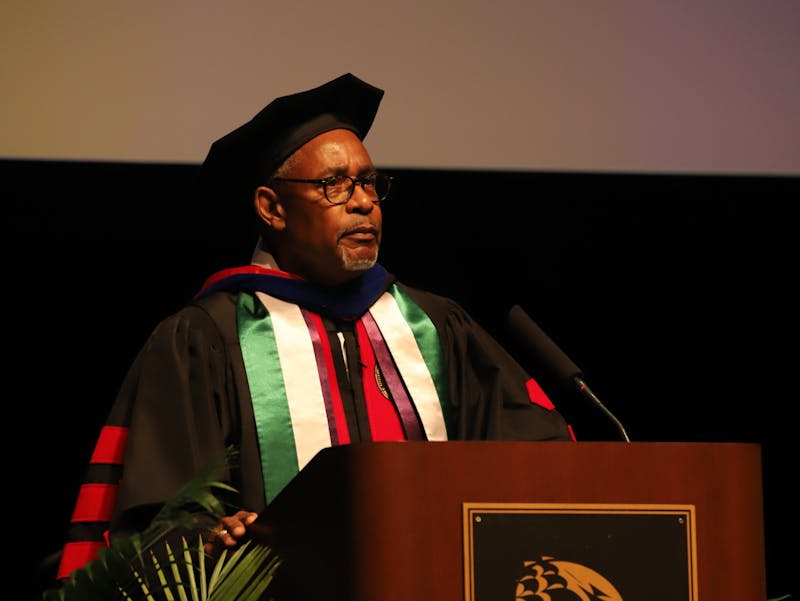Crime and the media was the topic of discussion between professors at the 12th annual criminal justice symposium Thursday in Shippensburg University’s Old Main Chapel.
Criminal justice professor Stephanie Jirard served as the moderator and began the symposium by introducing the topic of the Lindbergh kidnapping, which was one of the first crimes heavily sensationalized by the media and which made the cover of Time magazine.
Communication/Journalism professor Michael Drager was the first panelist to speak on the topic. Covering crime began in the 1830s, and eventually images were used to enhance these stories, Drager said.
Some images depict police as protectful and ready to serve, but some images also portray intimidation and subjugation. Editors are gatekeepers who filter these images so they portray accuracy and context.
With new technology, however, editors are no longer the only people that can allow these images to be spread to the public.
“With a smartphone anyone can be a citizen journalist. Anyone can report events as they happen,” Drager said.
But context is not always provided in these situations. In 1991, images of Rodney King being beaten during his arrest in Los Angeles allowed Americans to realize the impact of a visual message. Some saw the officers doing their jobs, but others saw them using unnecessary force.
The term “perp walk” is an expression of criminality, and it is often the first look that allows people to put a face on the accused. These images do not go away whether the accused is guilty or not, and they still exist online, Drager said.
The news media releases these images and sometimes allows the public to assess the innocence or guilt of the accused, which they do not mean to.
Media organizations use news values to decide what photos to present and how to present them, Drager said.
“People in the news media understand there are consequences to what they present to the public because those images can often affect the public’s perception of the accused and in turn affect the outcome of the accused’s fate,” Drager said.
Sociology professor Lawrence Eppard spoke on how media coverage of crime might contribute to Americans’ perception of different racial ethnic groups. Americans tend to associate certain racial groups and criminality, he said.
“Certain crimes in this country are what we call racialized meaning, that some races are overrepresented,” Eppard said.
When images are shown on news broadcasts without context, the impression is that crime is racialized — not because of race, but because of poverty, unemployment, neighborhood quality and segregation.
Eppard presented a study that found the perception of African-Americans as perpetrators and whites as victims is not representative of actual statistics.
A third issue he raised was racialized framing. This does not only involve the number of people in stories, but the content of the stories.
“In general, in the content of stories you see, African-Americans present as lower status, as more violent, as more threatening and just generally more negative,” Eppard said.
He suggested that media do not provide images without context of why the images are racialized, avoid over representation and pay attention to framing of stories.
Criminal justice professor Laura Beckman began by mentioning that a lot of people have not been exposed to crime, and their main source of information about crime is the media. However, the media is often biased about how they report crime because it’s more sensationalized.
Beckman focused her argument on the points that the media over-report violent crime, choose victims who are particularly innocent, choose crimes where the victim and offender are strangers, do not report the cause of a crime and portray cases where the justice system has failed.
“Based on this, the public concludes that crime is rampant, it’s random, the offender is particularly blame-worthy and the justice system is too lenient,” she said.
The public’s perception of crime is then beyond the odds of reality. As a result of this, the public believes punishments should be more punitive, according to Beckman.
Political science professor Steven Lichtman focused on how crime in the media affected the federal government. However, crime is usually more of a state and local issue. It often did not have to do with a national election.
In 1968 crime was inserted into the election of Humphrey vs. Nixon. Nixon made the issue of crime part of his campaign and said the disorder in America was a result of the Humphrey Administration.
“It worked. Nixon won,” Lichtman said.
In 1988, the Bush campaign hired Lee Atwater as its campaign manager.
“Lee Atwater’s approach to politics was ‘find something about your opponent that’s going to make them look bad and relentlessly pound it,’” Lichtman said.
Atwater spread stories that Dukakis was lenient on crime; however, the president does not really deal with crime.
“The president of the United States has very little to do with crime policy,” Lichtman said. “To say that Michael Dukakis’s record on crime is relevant to how he will conduct himself as president was a fundamental irrelevancy.”
He believes that something in today’s society has flipped. Today, there is not a focus on a political party’s stance on a topic, instead there is a focus on identity politics, and crime is used to get to that point.
The symposium ended with a question and answer session that allowed students and faculty to ask specific panelist questions about the topic of crime and the media.




The Slate welcomes thoughtful discussion on all of our stories, but please keep comments civil and on-topic. Read our full guidelines here.